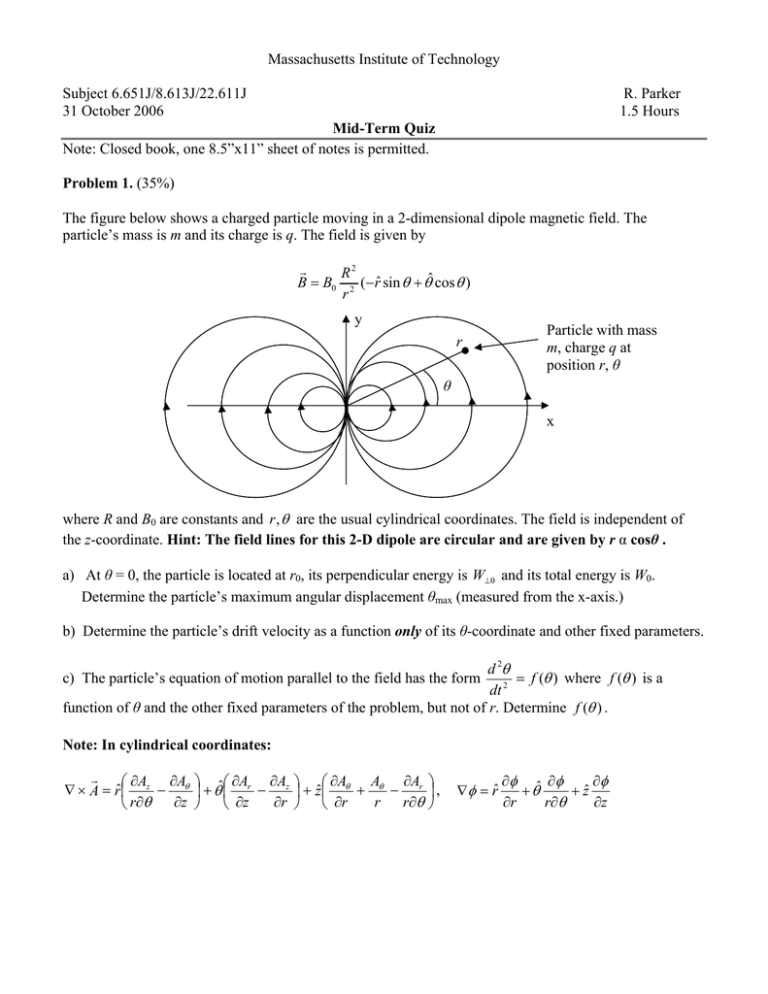Massachusetts Institute of Technology Subject 6.651J/8.613J/22.611J R. Parker
advertisement

Massachusetts Institute of Technology Subject 6.651J/8.613J/22.611J 31 October 2006 R. Parker 1.5 Hours Mid-Term Quiz Note: Closed book, one 8.5”x11” sheet of notes is permitted. Problem 1. (35%) The figure below shows a charged particle moving in a 2-dimensional dipole magnetic field. The particle’s mass is m and its charge is q. The field is given by r R2 B = B0 2 (− rˆ sin θ + θˆ cos θ ) r y r Particle with mass m, charge q at position r, θ θ x where R and B0 are constants and r , θ are the usual cylindrical coordinates. The field is independent of the z-coordinate. Hint: The field lines for this 2-D dipole are circular and are given by r α cosθ . B a) At θ = 0, the particle is located at r0, its perpendicular energy is W⊥0 and its total energy is W0. Determine the particle’s maximum angular displacement θmax (measured from the x-axis.) b) Determine the particle’s drift velocity as a function only of its θ-coordinate and other fixed parameters. d 2θ = f (θ ) where f (θ ) is a c) The particle’s equation of motion parallel to the field has the form dt 2 function of θ and the other fixed parameters of the problem, but not of r. Determine f (θ ) . Note: In cylindrical coordinates: r ∂A ⎞ A ∂A ⎞ ⎛ ∂A ⎛ ∂A ∂A ⎞ ⎛ ∂A ∇ × A = rˆ⎜ z − θ ⎟ + θˆ⎜ r − z ⎟ + zˆ⎜ θ + θ − r ⎟ , ∂z ⎠ ∂r ⎠ ⎝ ∂r r r∂θ ⎠ ⎝ ∂z ⎝ r∂θ ∇φ = rˆ ∂φ ∂φ ˆ ∂φ +θ + zˆ ∂z ∂r r ∂θ Problem 2. (35%) The figure below illustrates a collision between two particles. In the case shown, the shaded particle ψ y m1, v0 b x has infinite mass and is therefore stationary during the collision. The moving particle has mass m1, speed v0 and the impact parameter for the collision is b. The force between the two particles is k/r3 where k is a constant and r is the distance of separation. The force is repulsive and acts along a line connecting the particles. a) Determine the distance of closest approach, rmin, i.e., the minimum distance between the particles during the collision event. b) Calculate the angular deflection ψ of the incident particle and the impact parameter, b90, for a 90º collision. One of the integrals on the next page should be useful to you in answering this part. Assume now that the particle at the origin has finite mass m2 and is stationary before the collision. c) Calculate, in terms of ψ, the loss in x-directed momentum suffered by particle 1 as a result of the collision. d) Consider now a beam of particles with mass m1 and velocity x̂vx injected into a “sea” of initially stationary particles with mass m2. (The force of interaction continues to be k/r3.) The initial rate of momentum loss of the beam particles is υ p m1v x where υ p = n2σ p v x . and n2 is the density of particles with mass m2.. The cross-section σ p is determined by an integral of the form ∞ σ p = ∫ f (b)db 0 Determine f (b). Integrals: ∫ ∫ ∫ ∫ dx x −a 2 xdx x −a 2 ∫x 2 x 2 dx x2 − a2 x 3 dx x2 − a2 ( = ln x + x 2 − a 2 x −a 2 = x x2 − a2 a2 + ln( x + x 2 − a 2 ) 2 2 = ( x 2 − a 2 )3 / 2 + a2 x2 − a2 3 2 dx 2 x2 − a2 = 1 a cos −1 a x = x2 − a2 a2 x 1 x2 − a2 x = + 3 sec−1 2 2 2 2 2a x 2a a x −a dx 3 ) = x2 − a2 dx ∫x ∫x 2 Problem 3. (30%) r The figure below depicts a long z-pinch with magnetic field B = θˆB (r ) and pressure p (r ) . The pinch has a circular cross-section radius and the pressure vanishes at the radius a. The mass density ρ is constant, ρ = ρ0. Assume in this problem that the usual MHD equation of state pρ −γ =const is not valid for the equilibrium, and that the pressure can be determined independent of the density. y r J θ x 2a B lines r a) The plasma is undergoing rigid-body rotation in the θ-direction, i.e., the plasma velocity is V = θˆ rΩ where Ω is a constant. What is the relationship among B (r ) , p (r ) and Ω necessary to assure MHD equilibrium? r b) The current density in the z-pinch is constant, i.e., J = zˆJ 0 where J 0 is a constant. Solve the equation found in part a) to determine p (r ) assuming that p ( a ) = 0 where a is the outer radius of the z-pinch. c) Determine the β of the plasma define as β = 2 ( 2 a a ∫ p(r )rdr ) 0 Bθ2 (a ) 2μ 0 . Possibly useful formula: r ⎛ ∂b a ∂b r ∂b a b ⎞ ⎛ ∂b a ∂b ∂b a b ⎞ a • ∇b = rˆ⎜ ar r + θ r + a z r − θ θ ⎟ + θˆ⎜ ar θ + θ θ + a z θ + θ r ⎟ r ∂θ r ⎠ ⎝ ∂r r ∂θ r ⎠ ∂z ∂z ⎝ ∂r ∂b ⎞ ⎛ ∂b a ∂b + zˆ⎜ ar z + θ z + a z z ⎟ r ∂θ ∂z ⎠ ⎝ ∂r




